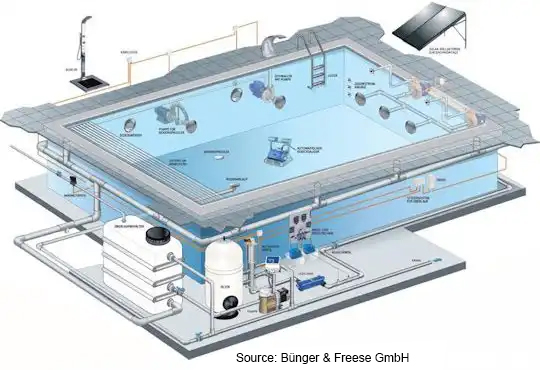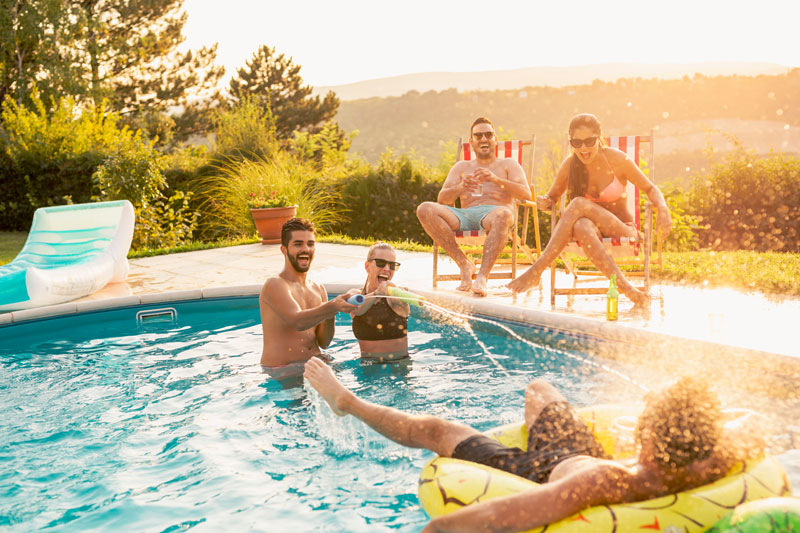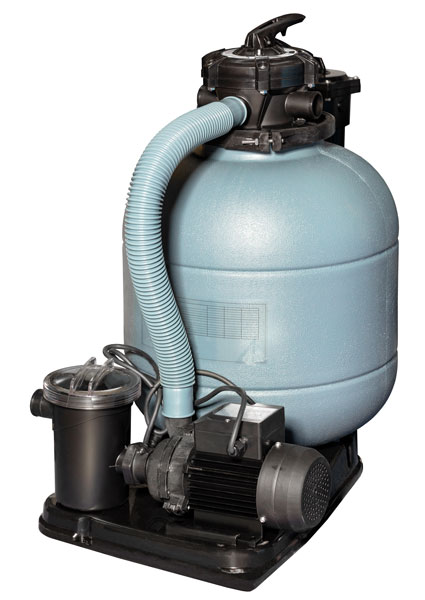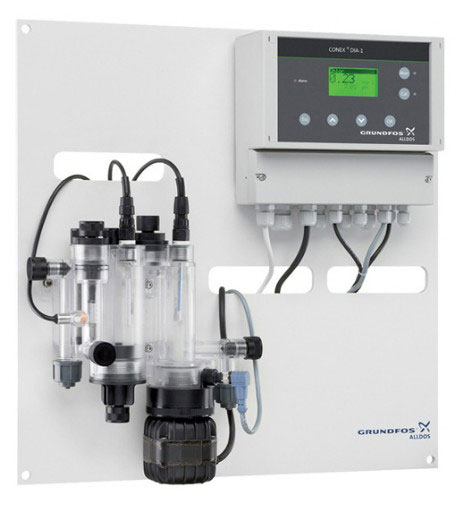Swimming pool technology
WATER TREATMENT IN POOLS WITH OVERFLOW CHANNELS – STANDARD PROCEDURE IN PUBLIC SWIMMING POOLS
Water treatment for a pool with an overflow channel (public area)
As a rule, such pools have vertical flow. The inlet nozzles are located in the pool floor. The inflowing pool water can thus transport dirt particles in the bathing water to the water surface. From there, they are transported with overflowing bathing water through a circulating channel into an overflow collection tank. The overflow collection tank acts as a buffer and, at the same time, as a storage tank for regulating the water level by feeding in fresh water. The circulation pump draws the bath water from the overflow collection tank, directs it to the filter and then back to the inlet nozzles. To improve the filtering effect by increasing the volume of particles, a flocculant dosing system is installed upstream of the filter. To disinfect the bath water, the pH value, chlorine and redox potential are measured. Since the effectiveness of chlorine depends on the pH value, this must be regulated. Disinfection is carried out using chlorine.
The following methods are mainly used for this purpose:
- Dosing of sodium hypochlorite (NaOCl)
- Addition of chlorine gas
- Production of chlorine from sodium chlorite via electrolysis
The addition of disinfectants must be regulated.

Water treatment for public swimming pools with overflow channels.

Water treatment with surface skimmers ensures crystal-clear, hygienically clean water – ideal for a relaxed pool party and carefree swimming fun in a well-maintained private pool.
Photo: Impact Photography | adobe stock
Water treatment for a pool with surface skimmer (private area)
There are more options for design and water treatment in private areas than in public areas. For example, in addition to chlorine, the bathing water can also be disinfected with active oxygen, an agent with a corresponding peroxide content.
Components for the design of private pools are:
- Prefabricated pools (GRP pools, foil pools)
- Attractions (slides, counter-current swimming systems, underwater spotlights)
- Covers for outdoor pools
- Swimming pool cleaners
- Ladders and steps
SCHWIMMBADFILTER
Swimming pool filters are made from a variety of materials. Common designs include GRP (glass-reinforced plastic) and stainless steel tanks. Steel filters are often used for particularly high flow rates and are coated with rubber on the inside to prevent corrosion.
In order to achieve an effective reduction in bound chlorine and a high level of filtration, the filters are often equipped with a multi-layer filter filling. This consists of several layers of different grain sizes, typically quartz gravel and anthracite, which together enable particularly thorough cleaning of the water.
The complete filter system also includes piping, circulation pumps, a multi-way valve and a water sampling station for continuous monitoring of the water quality in circulation. In automated filters, the multi-way valves are controlled fully automatically, which makes operation particularly efficient and low-maintenance. The main task of swimming pool filters is to remove dirt particles, sand, hair and other contaminants from the pool water. In public swimming pools, filter speeds of up to 30 m/h are permitted. In addition, these filters must be equipped with two sight glasses so that their function and backwashing can be visually checked. Our swimming pool filters are available as standard for flow rates from 5 m³/h to 32 m³/h. We are happy to offer other sizes and designs on request.

Multi-layer filters with quartz gravel and anthracite reduce bound chlorine in the water through effective depth filtration. Photo: Sergii | adobe stock
DOSING SYSTEMS
Dosing systems in swimming pools are used for the following tasks:
- Flocculant dosing, quantity-controlled or time-controlled
- pH value dosing, addition of alkaline or acidic agents for pH value adjustment, regulated operation
- Disinfectant dosing as
- Chlorine gas dosing, regulated
- Sodium hypochlorite dosing, regulated
- Electrolysis process for producing a chlorine solution, regulated dosing
- Active oxygen dosing, regulated or time-controlled (only in private areas)
Setting values for dosing in swimming pools (guidelines) pH value: < 7.0 Redox potential: > 750 mV Free effective chlorine: 0.3 – 0.6 mg/l
SWIMMING POOL CHEMICALS AND ACCESSORIES
Swimming pool chemicals are consumables required for the operation of swimming pools.
Our product range includes:
- Disinfectants (sodium hypochlorite 12%, chlorine granules, duochlorine)
- Flocculants
- pH reducers and pH increasers
- Detection reagents for photometers
- Buffer solutions for calibrating pH and redox electrodes
- Hand-held measuring devices for chlorine, pH value, temperature
SWIMMING POOL RULES
In order to regulate swimming pool water parameters, the pH value, redox potential and chlorine value must be measured. To do this, water is taken from the swimming pool and the actual values of the parameters are determined in measuring stations equipped with the appropriate measuring probes.
A swimming pool controller is used to control the various dosing devices. Swimming pool controllers can be equipped with a real-time clock, interfaces for remote data transmission and remote parameterisation. In addition to controlling the chemical parameters, it is also possible to control the water temperature when using heat exchangers – either via the swimming pool controller or via a separate controller. The basic prerequisite for a consistent disinfection potential of the swimming pool water is the measurement and control of these variables.
Factors influencing the varying consumption of swimming pool chemicals are:
- Contamination (dust, leaves) in outdoor pools
- Number of visitors
- Water temperature, sunlight
- Settings
- Regular inspections and maintenance

Swimming pool control system from Grundfos GmbH: Precise measurement of pH value, redox potential and chlorine value forms the basis for automated water quality control. The controller regulates dosing systems and, if required, also enables temperature control – for hygienically perfect and optimally tempered swimming pool water.
Photo: Grundfos GmbH
 DE
DE  EN
EN 